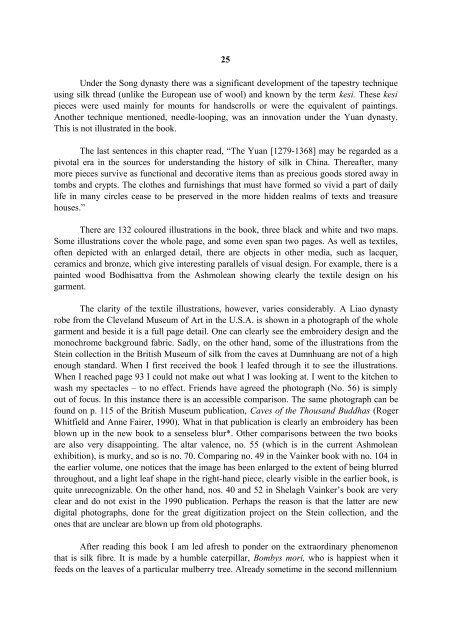download - OATG. Oxford Asian Textile Group
download - OATG. Oxford Asian Textile Group
download - OATG. Oxford Asian Textile Group
Create successful ePaper yourself
Turn your PDF publications into a flip-book with our unique Google optimized e-Paper software.
25<br />
Under the Song dynasty there was a significant development of the tapestry technique<br />
using silk thread (unlike the European use of wool) and known by the term kesi. These kesi<br />
pieces were used mainly for mounts for handscrolls or were the equivalent of paintings.<br />
Another technique mentioned, needle-looping, was an innovation under the Yuan dynasty.<br />
This is not illustrated in the book.<br />
The last sentences in this chapter read, “The Yuan [1279-1368] may be regarded as a<br />
pivotal era in the sources for understanding the history of silk in China. Thereafter, many<br />
more pieces survive as functional and decorative items than as precious goods stored away in<br />
tombs and crypts. The clothes and furnishings that must have formed so vivid a part of daily<br />
life in many circles cease to be preserved in the more hidden realms of texts and treasure<br />
houses.”<br />
There are 132 coloured illustrations in the book, three black and white and two maps.<br />
Some illustrations cover the whole page, and some even span two pages. As well as textiles,<br />
often depicted with an enlarged detail, there are objects in other media, such as lacquer,<br />
ceramics and bronze, which give interesting parallels of visual design. For example, there is a<br />
painted wood Bodhisattva from the Ashmolean showing clearly the textile design on his<br />
garment.<br />
The clarity of the textile illustrations, however, varies considerably. A Liao dynasty<br />
robe from the Cleveland Museum of Art in the U.S.A. is shown in a photograph of the whole<br />
garment and beside it is a full page detail. One can clearly see the embroidery design and the<br />
monochrome background fabric. Sadly, on the other hand, some of the illustrations from the<br />
Stein collection in the British Museum of silk from the caves at Dumnhuang are not of a high<br />
enough standard. When I first received the book I leafed through it to see the illustrations.<br />
When I reached page 93 I could not make out what I was looking at. I went to the kitchen to<br />
wash my spectacles – to no effect. Friends have agreed the photograph (No. 56) is simply<br />
out of focus. In this instance there is an accessible comparison. The same photograph can be<br />
found on p. 115 of the British Museum publication, Caves of the Thousand Buddhas (Roger<br />
Whitfield and Anne Fairer, 1990). What in that publication is clearly an embroidery has been<br />
blown up in the new book to a senseless blur*. Other comparisons between the two books<br />
are also very disappointing. The altar valence, no. 55 (which is in the current Ashmolean<br />
exhibition), is murky, and so is no. 70. Comparing no. 49 in the Vainker book with no. 104 in<br />
the earlier volume, one notices that the image has been enlarged to the extent of being blurred<br />
throughout, and a light leaf shape in the right-hand piece, clearly visible in the earlier book, is<br />
quite unrecognizable. On the other hand, nos. 40 and 52 in Shelagh Vainker’s book are very<br />
clear and do not exist in the 1990 publication. Perhaps the reason is that the latter are new<br />
digital photographs, done for the great digitization project on the Stein collection, and the<br />
ones that are unclear are blown up from old photographs.<br />
After reading this book I am led afresh to ponder on the extraordinary phenomenon<br />
that is silk fibre. It is made by a humble caterpillar, Bombys mori, who is happiest when it<br />
feeds on the leaves of a particular mulberry tree. Already sometime in the second millennium
















